
| This is wireless.gumph.org's cached copy of http://www.wireless.org.au/~jhecker/helix/helical.html The original page may have changed since we took this copy. Click on this link to go to the original page. |
Introduction
As some of the readers may know, an effort by members of the Canberra Linux Users Group has been launched to set up a Canberra-wide wireless LAN. This amateur experiment's existence is largely due to the acquisition of many cut-price old style Lucent WaveLAN cards being superseded by the IEEE 802.11 standard cards. The cards were cheap but the tile antennas that came with them are no good for long haul links of more than several hundred metres. On top of this, commercial aerials that can do the job are expensive, can get rather large and are ugly, especially the conifers. My Mum would not want one on her roof.
Consequently, there is no reason why this aerial couldn't also be used with any other equipment that requires a broad bandwidth in the 2.425GHz band such as the new 802.11 wireless network cards or video transmitters. If anyone does use the aerial with these bits of equipment, please let me know!
The idea behind this aerial was for anyone to be able to make their own aerial for point to point links, and do it cheaply. The criteria are cost effectiveness, ease of construction and durability. Durability is important as you don't want wind, beak cleaning magpies and highly destructive nibbling cockatoos ruining your Quake III and Unreal Tournament sessions. Birds landing on the aerial have the effect of severely diminishing the signal, too.
The aerial was derived from information on helical antennas in the ARRL Antenna book.
Any places and shops referenced are in Canberra, Australia.
Parts
To construct one aerial you will need:
You can get the U-bolts and nuts and washers from Hardware House or BBC.
The brass shim is available
in whatever length you need from Belconnen Metal Centre. They have
cans of the stuff rolled up. Tuggeranong Metal Centre should have
it too.
Construction
-Print and cut out the templates in the PDF template file. circle.pdf and rhspiral.pdf or lhspiral.pdf Use rhspiral for right handed spiral helicals and lhspiral for left handed spirals. You will need the circle to make the ground plane (reflector), unless you can prescribe a good 130mm diameter circle yourself with a ruler and circumference.
UPDATE! - Download HelixCalc from the theory section below to design your own templates.
-Cut a length of 40mm PVC to 550mm (55cm).
-Wrap the winding template around the PVC tube and tape the seam together. It doesn't matter if you use the RIGHT or LEFT handed template so long as the helical at the other end is the same. Make sure the spirals line up the at the seam. A small gap at the seam is OK. If you combine a left handed aerial with a right handed aerial then you'll get virtually no usable signal.

- The end you start the template at will be the end that connects to the base. Note, you should start with the template protruding about the thickness of the endcap over the edge. See diagram below. This will compensate for the thickness of the 40mm endcap.
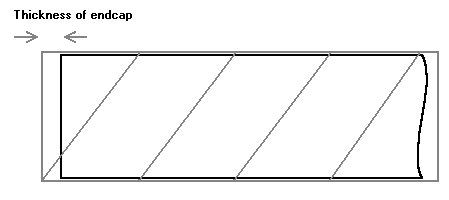
- Using a sharp point like a scribe, perforate the template along the helical line at regular intervals, say 5 or 6 per revolution. This will leave marks in the PVC you can follow when wrapping the wire around. Slide the template along in stages until you gave a complete spiral running the length of the tube. Mark the where the end of the spiral on the template finishes. You should have a few mm of tube left over. This is OK.
- Take the 1mm wire spool and using something like superglue or Loctite 424 attach the end of the wire to where the spiral ends at the tube (the end point described above.). Slowly wind the wire around the tube, following the spiral indentations. At fairly regular intervals like a 1/2 or 1/3 turn add some more glue to hold the wire in place.
- As you approach the base end don't glue down the last turn and leave plenty of excess wire (10cm or so) hanging off the end. Let the glue dry.
- Cut out from the brass shim or Sara Lee pie tin the 130mm diameter circle (from circle.pdf).
- Drill holes in the 150mm endcap and 130mm sheet to allow for the centre bolt and N connector holes to come though. I marked the positions of everything by centreing the base of the 40mm endcap onto the base of the 150mm endcap and drawing the circumference as you can see below. I then positioned the N connector over the outline to see where it needed to fit, seeing as the N connector stub has to be right on the outer edge of the 40mm tube.

- Take the 40mm PVC endcap and cut off a section big enough to allow the N connector stub and three nut holes room to poke through. The sketch below will give you an idea of how much you want to cut off to allow for the stub and bolt holes to fit when it all comes together.
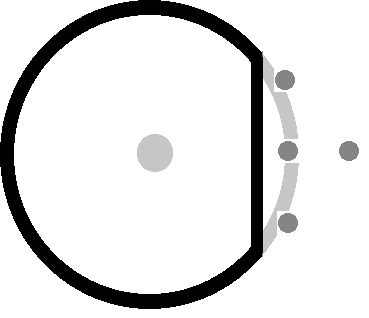
- Drill a hole in the endcap suitable for the 5/16" bolt. With the side cut off and hole drilled it should look like thus:
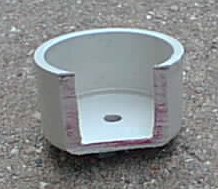
- All bolted together you should end up with (the picture doesn't show the reflector or N connector in place).

- For the U-bolt mounts I'll leave it up to you as to what size U bolts, 25mm or 35mm or whatever. Make sure that when you drill the holes to place them in that it's off to the side and the antenna mast won't impede you from plugging in the N-connector. See the pictures below for how I placed the U-bolts.
- Place the 130mm brass or aluminium circular sheet on the big 150mm endcap, and bolt on the 40mm endcap, making sure all the holes on the sheet and big endcap line up.
- Attach the N connector.
- In order to match the antenna (from it's nominal 150ohms to the connector's and cables' 50ohm impedance) you need a strip of copper or brass about 15-20mm wide. I happened to have some adhesive copper tape at my work. You need a length that will follow the marked line where the spiral winds along the tube to the end. It has to span from one corner of the strip, winding along the spiral until the diagonally opposite corner will poke out above the endcap when everything is placed together. Cut the strip in half along the diagonal so you end up with a triangle that tapers to the corner. Strip dimensions of the adjacent sides 17mm and 71mm respectively with the hypotenuse 73mm should work. Aluminium won't solder so don't bother using that. Brass shim should do the trick though. See the diagram below on how to measure it up and place it.
- Insert the tube into the 40mm endcap and mark where the spiral meets the top of endcap. Cut the wire off at this point but leave a few mm of excess wire. With the sandpaper, scrape off the enamel off the end of the wire to leave it shiny and easy to solder.
- Carefully solder the narrow pointy end of the tapered strip to the wire and match up where the lower corner at the large end will solder neatly onto the stub of the N connector. You might need to use glue or sticky tape to hold it in place. You might have to do some trimming to get the strip to the correct length. This strip in effect acts as an impedance transformer. I don't know quite how it works, but I've done it four times with each strip of slightly different lengths and according the to two-port analyser it works well.

- When the tube is fully inserted into the endcap it should click in place and hold fast. Be satisfied that the taper is in place when wound around so the corner can neatly solder to the N connector stub.
- Take the tube out and with the sandpaper roughen the inside of the 40mm endcap and adjacent surfaces on the tube. This should help the glue hold better. Before you glue, wipe all the roughened surfaces clean.
- Get some SLOW DRYING (not 5 min) Araldite and mix up a batch. Apply the Araldite to the tube end section and inside the endcap. Reinsert the tube as described above, aligning the copper strip corner and N connector stub. Lots of glue should ooze out. Solder the corner of the taper to the centre pin of the N connector. Make sure there is plenty of glue filling the small gap between the tube and the inner circumference of the endcap.
- Let the glue dry (about a day). Install on the U-bolts and you have yourself a helical! With the taper in place and everything glued up and bolted together you should have something looking like the picture below. You can see the N connector bolts and centre stub poking through the brass shim. Also visible is the taper corner soldered to the stub and everything covered in globs of dried Araldite.

The reason for the big endcap was so a length of 150mm PVC pipe could
slide over the whole assembly and snugly fit into the endcap. With
another endcap on the other end completely sealing the unit, water and
birds would be kept off the aerial and it should last longer. If
you are going to leave the aerial exposed, make sure you put liberal amounts
of silicone around the N connector where the taper solders on and ensure
that no water can electrically connect the centre wire of the aerial to
the ground plane (the sheet.) Experience has shown that poor performance
in rain and fog due to condensation on the connector kind of shorting out
the ground and centre signal pin. I have noticed that the zinc coating
on the U-bolt washers and brass shim had galvanic reactions happening so
plastic or rubber washers might be needed instead here to prevent deterioration
of the brass.
Here is a picture of the finished product!

And from the back....

Kind of Important Stuff
-The PVC tube I used didn't get hot in the microwave oven even after two minutes, so it shouldn't absorb any signal from the WaveLAN. Test your tube (or other tube shaped materials you will use as an aerial winding former (not metal)) in the microwave for a minute (with a small glass of water too) and make sure it doesn't get warm or hot. If it does, it's no good for making an aerial with.
- The matching section described above worked for me in several incarnations, all of which were ad hoc. I was amazed when the two port analyser told indicated how well the matching circuit worked.
- Until I do some more testing, I won't make any claims that this aerial should work to 10Kms (though they well might and it's the maximum range intended). They do work well to 3-4Km with a good line of sight (not much in the way like trees and house roofs).
- Possible variations on this aerial design abound. You'll have
to use your imagination to come up with workable variations. Using
single sided unetched printed circuit board for the backplane is one, as
the fibreglass board is quite strong and the copper is already bonded to
the board which you can use as the reflector.
Theory
The design for this aerial was derived from the good ol' ARRL Antenna Handbook. From chapter 19 are a bunch of helical designs and some maths detailing how to paramterise and gauge the performance of the aerial.
I have lost my original design notes, so I am rederiving this from the PDF files and measuring the aerials I made.
The following formulae are from page 19-23 of the ARRL Antenna Handbook. I am repeating them here as not everyone has access to this book.

Cl = 0.75 to 1.33 l
circumference of winding
Sl = 0.2126 Cl
to 0.2867 Cl
axial length of one turn
G = 0.8 to 1.1 l
diameter of ground plane / reflector
Cl = p
Dl
circumference is pi times the diameter
The diameter of the winding is fixed, with the PVC tubing being 42mm
in diameter.
The centre frequency (2.425GHz) has a wavelength l
= 0.123711 metres.
Cl = p
* 0.042m = 0.13195m
= 1.066 l
Looking back at the measurements, I may have screwed up somewhere because Sl seems to be 0.31830 Cl, which is out of range of the specified values. I don't know how this came to be, but it doesn't seem to be too big an impediment.
Sl = 0.3183 * 0.13195m = 0.042m (strangely enough, the diameter of the tubing.)
The ground plane diameter G = 1.05 l = 0.130m
The gain of the aerial in dBi is defined as:
Gain = 11.8 + 10log10(Cl * Cl * n * Sl) where n is the number of turns.
Gain = 11.8 + 10log10(1.066 * 1.066 * 13 * 0.31830)
= 18.5dBi
The chart below shows the amount of gain to be had for the number of turns. As you can see, to get about 3dB (twice) more you have to double the number of turns and double the length of the aerial. Thirteen turns happens to fit into 0.55m and is a good compromise for length versus gain.

A lot of the newer 802.11 cards allow for a selection of centre frequencies (channels). You might want
to vary the winding dimensions by using the above formulae to calculate new Cl and Sl.
Some people (namely some ham radio types who know what they are doing)
have built the antenna and found the gain wasn't as good as the theory
suggests. I assume that they built the antenna properly and had good
impedance matching. This page
suggests that helicals could have their gains overestimated by the standard
Kraus formula (as used here) by up to 4-5dB. This would have a severe effect
on calculated link budgets, especially marginal ones. If anyone in the know
has any ideas on this or some empirical evidence, please get in contact with
me.
HelixCalc
I have written a little utility to design and print templates to suit - so you aren't restricted to the templates I generated. You can alter various parameters (as described above) and it will print out a winding template and backplane. You can do it in centimetres or inches. Unfortunately, there is a bug (lesson: don't debug code while drinking scotch). The total antenna length is wrong. Manually calculate the total antenna length by multiplying the number of turns by the single winding Slambda shown at the bottom of the util. I have lost the source code and may get around to redoing it sometime. The printed antenna template is still OK though! HelixCalc Note that this is a Windows only program. I don't know if it will run in WINE.
New! This online helix calculator by Caleb Crome should do the job of HelixCalc without the annoying bug.
Performance
I have measured the efficiency of these aerials by measuring the S11 parameters. Below are measuremeants for both aerials I constructed. The upper diagram is the SWR measurement, and lower is the log return measurement. Both aerials are very good and have the broadband required for spread spectrum communications (SWR of 1:1.15 or better!). It would seem the ad-hoc aerial matching strip actually works extremely well! I have yet to test the performance over distance.
Have a look here for some photos of antennas that myself and others have made. If you have made an antenna based on this design, please send me some photos and a description so I can add them to this section.
Aerial #1
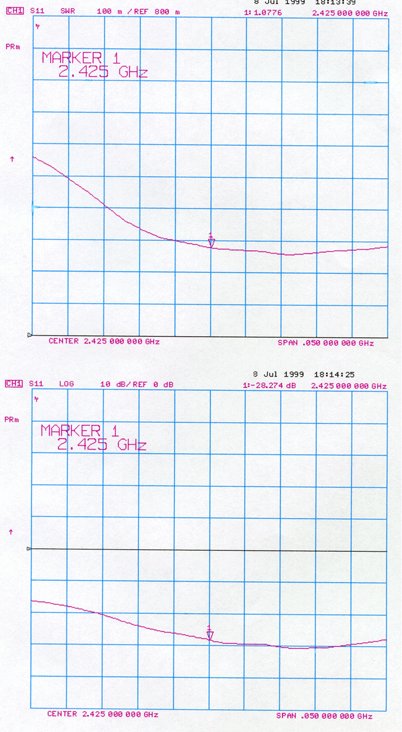
Aerial #2

Beam Patterns
Below are some beam pattern measurements. Unfortunately due to the setup I was only able to measure the frontside 180 degrees. The first beam pattern was sampled at 5 degree intervals for 40 degrees and mirrored to give a full beam. The -3dB points as marked agree with the theory that the beam is about 25 degrees wide. The second beam patterns was coarser with 10 degree intervals used over 90 degrees. This clearly shows the first null at about 40 degrees off the boresight. The ratio between the main beam maximum and side lobe maximum was about 10dB. The front to back ratio was measured at 20dB.
Half Power Beam Width = 52 / (Cl
* sqrt(n * Sl)) degrees
= 52 / (1.066 * sqrt(13 * 0.31830))
= 23.98 degrees
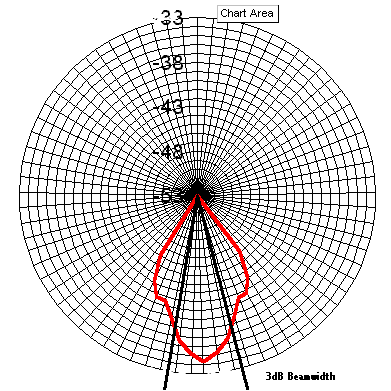

(C)opyright 1999-2003
Jason Hecker 
Thanks to Mark Hulskamp for photos and his assistance. Thanks also to
Ramon Donnell for some of the photos. Thanks to CEA Technologies for the use of their network
analyser.
Home
Updated: 1 Jan 2003